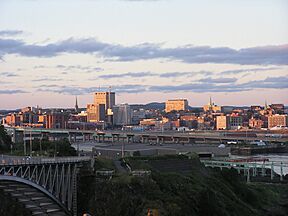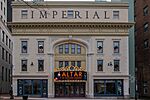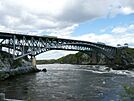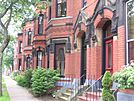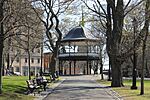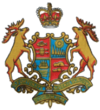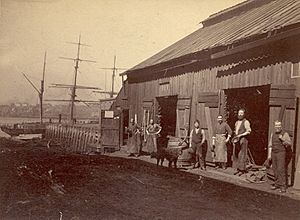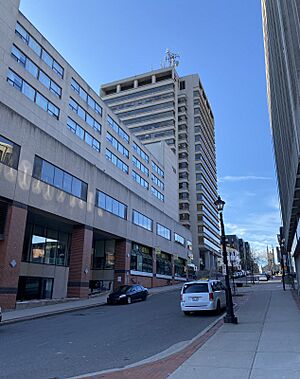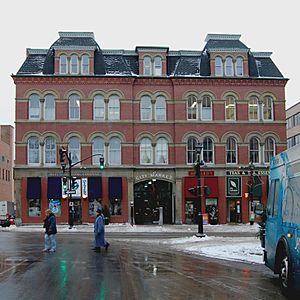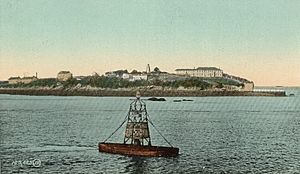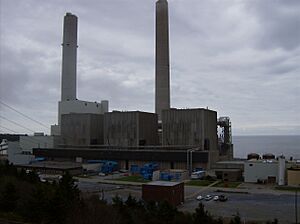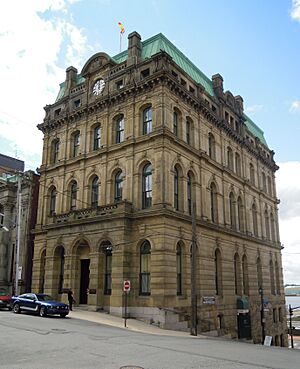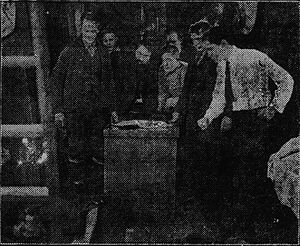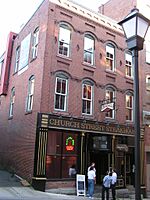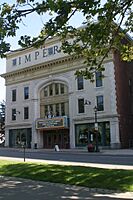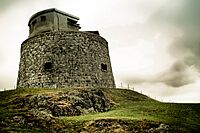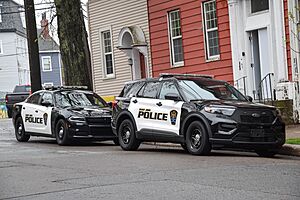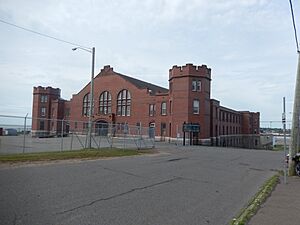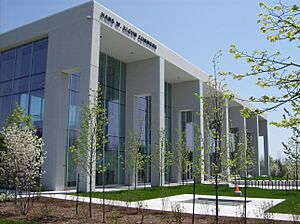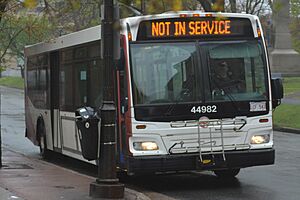Saint John, New Brunswick facts for kids
Quick facts for kids
Saint John
|
|||
|---|---|---|---|
|
City
|
|||
| The City of Saint John | |||
|
Skyline of Uptown Saint John
Reversing Falls Bridge
Germain Street row houses
King's Square
|
|||
|
|||
| Nickname(s):
"Port City"
|
|||
| Motto(s):
"O Fortunati Quorum Jam Moenia Surgunt"
(Latin for, "O Fortunate Ones Whose Walls Are Now Rising." or "O Happy They, Whose Promised Walls Already Rise") |
|||
| Country | Canada | ||
| Province | New Brunswick | ||
| Historic countries | Kingdom of France Kingdom of Great Britain United Kingdom of Great Britain and Ireland |
||
| County | Saint John | ||
| Parish | City of Saint John | ||
| Founded on | June 24, 1604 | ||
| Major Settlement Started | 1783 | ||
| Incorporation | May 18, 1785 | ||
| Named for | Saint John River | ||
| Area | |||
| • Land | 315.59 km2 (121.85 sq mi) | ||
| • Urban | 70.05 km2 (27.05 sq mi) | ||
| • Metro | 3,505.66 km2 (1,353.54 sq mi) | ||
| Highest elevation | 80.8 m (265.1 ft) | ||
| Lowest elevation | 0 m (0 ft) | ||
| Population
(2021)
|
|||
| • City | 69,895 | ||
| • Density | 221.5/km2 (574/sq mi) | ||
| • Urban | 63,447 | ||
| • Urban density | 905.8/km2 (2,346/sq mi) | ||
| • Metro | 130,613 | ||
| • Metro density | 37.3/km2 (97/sq mi) | ||
| • City Pop 2016–2021 | |||
| • Dwellings | 31,825 | ||
| Demonym(s) | Saint Johner, Saint-Jeannois(e), Johner (colloquial) | ||
| Time zone | UTC– 04:00 (AST) | ||
| • Summer (DST) | UTC– 03:00 (ADT) | ||
| Canadian Postal code |
E2H, E2J, E2K, E2L, E2M, E2N, E2P, E2R, and E2S
|
||
| Area code | 506 and 428 | ||
| Telephone exchanges | 202, 214, 333, 343, 557–8, 592, 608, 631–640, 642–654, 657–8, 663, 672, 674, 693–4, 696, 721, 977 | ||
| Highways | |||
| NTS Map | 21G8 Saint John | ||
| GNBC Code | DAEGW | ||
| GDP (Saint John CMA) | CA$6.4 billion (2016) | ||
| GDP per capita (Saint John CMA) | CA$51,021 (2016) | ||
Saint John is a busy port city located on the Bay of Fundy in New Brunswick, Canada. It is Canada's oldest city to be officially recognized, getting its royal charter on May 18, 1785. The port is Canada's third-largest for shipping goods. It handles many types of cargo, including large amounts of dry and liquid materials, as well as containers and cruise ships.
The city has a strong industrial side, with oil refining and manufacturing. It also has important finance and tourism industries. Saint John is home to research places like the New Brunswick Museum and the University of New Brunswick.
French explorer Samuel de Champlain arrived at Saint John Harbour on June 24, 1604. He named the Saint John River after St. John the Baptist. The local Mi'kmaq and Wolastoqiyik peoples called the river "Wolastoq." The Saint John area was key for trade and defense during the French colonial era. Fort La Tour, in the city's harbour, was a major battle spot during the Acadian Civil War.
For over a century, France and England argued about who owned the land around Saint John. In 1755, the British government sent away the Acadians after destroying Fort Menagoueche, which was later rebuilt as Fort Frederick. After American Privateers attacked Fort Frederick, Fort Howe was built in 1779.
In 1785, the City of Saint John was formed. It combined two communities, Parr-town and Carleton, on opposite sides of the harbour. This happened after thousands of refugees from the newly formed United States arrived. They wanted to remain loyal to Britain after the American Revolution. Over the next century, many immigrants came through Partridge Island, especially during the Great Famine. This greatly changed the city's people and culture.
Contents
- Saint John's Rich History
- Geography and Climate of Saint John
- Who Lives in Saint John?
- Saint John's Economy
- Culture and Arts in Saint John
- Public Safety in Saint John
- Education in Saint John
- Working Life in Saint John
- Media and Communication
- Getting Around Saint John
- Sports in Saint John
- Sister Cities of Saint John
- See also
Saint John's Rich History
The Saint John area has been home to the Wabanaki Confederacy for thousands of years. The Passamaquoddy Nation lived along the northwestern coast of the Bay of Fundy. The Wolastoqiyik Nation lived in the Saint John River valley. The Mi'kmaq also visited the Saint John area to hunt seals. The Wolastoqiyik people traditionally called the harbour area Menahkwesk. They still live in and around the city today. Before Europeans arrived, the Wolastoqiyik lived in villages. They ate bass, sturgeon, salmon, corn, and wild plants.
In 1604, Samuel de Champlain landed at Saint John Harbour. He did not settle there. Saint John was very important for trade and defense in Acadia during French rule. Fort La Tour was a key battleground during the Acadian Civil War. After the Seven Years' War, the British took control from the French.
More people came to Saint John from the former Thirteen Colonies and Europe. In 1785, Saint John became the first incorporated city in what is now Canada. This immigration led to the building of North America's first quarantine station, Partridge Island.
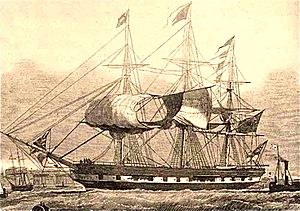
Saint John became a famous shipbuilding city. It built ships like the Marco Polo in 1851, which was the fastest ship in the world. The automated foghorn was also developed here by Robert Foulis.

As Saint John grew, some workers faced challenges. Black Saint Johners had limits on their trade, fishing, and voting rights. Many Black families moved to Portland, which later joined Saint John. In 1849, Canada's first labor union, the Laborer's Benevolent Association, was formed by longshoremen.
Between 1840 and 1860, there was a lot of violence in Saint John. This was due to poor living conditions for many Irish Catholics. In 1854, a cholera outbreak took over 1,500 lives. The Great Fire of Saint John in 1877 destroyed 40% of the city. It left 13,000 people without homes. The fire caused over $10 million in damage, which is about $256 million today. Saint John quickly rebuilt, but many people left the city.
Geography and Climate of Saint John
Physical Features of the City
Saint John is in the southern part of New Brunswick. It sits on the north shore of the Bay of Fundy, where the Saint John River meets the bay. The city is divided by the river. The east side is bordered by the Kennebecasis River. Saint John Harbour is a deep-water port that stays ice-free all year. Partridge Island is located in the harbour. The city covers about 315.96 square kilometers. The wider metropolitan area is about 3509.62 square kilometers.
The Stonehammer UNESCO Geopark is centered around Saint John. UNESCO recognizes it for its amazing geological features. The park has rocks that are up to a billion years old.
The Saint John River flows into the Bay of Fundy through a narrow gorge in the city center. This gorge has a unique event called the Reversing Falls. The Bay of Fundy's tides are so strong that they push ocean water back up the river for several kilometers. This makes the river flow backward for a few hours each day. There are also rapids at the narrowest part of the gorge.
The land around Saint John is hilly. This is because of two coastal mountain ranges: the St. Croix Highlands and the Caledonia Highlands. The soil is very rocky, with lots of granite. The coastal area has many freshwater lakes in the eastern, western, and northern parts of the city.
In Saint John, the difference between low and high tide is about 8 meters (28 feet). This is because the Bay of Fundy narrows, funneling the water. The Reversing Falls show how powerful these tides are. At high tide, ocean water pushes through the gorge, making the Saint John River flow backward.
Architectural Styles in Saint John
Saint John, especially in its Uptown area, has many different building styles. These styles come from the 19th and early 20th centuries. You can see Victorian, Romanesque Revival, and Second Empire buildings. Over time, the city also used Georgian, Greek Revival, Gothic Revival, Italianate, and Queen Anne styles.
After the Great Fire of Saint John in 1877, buildings were built with brick and stone instead of wood. In the late 1800s and early 1900s, Queen Anne and Romanesque styles were very popular. Some buildings in Saint John also have stone carvings and sculptures.
In 1982, Saint John created the Trinity Royal Heritage Conservation Area. This area helps protect old buildings and historic districts. A special rule, the Saint John Preservation Areas By-Law, makes sure that changes to these older buildings keep their historic look.
Some notable buildings in Saint John include:
- Courtney Bay Smokestacks (each 106.7 meters tall)
- Brunswick Square (80.8 meters tall), an office tower built in 1976. It is the largest office building in New Brunswick.
- Cathedral of the Immaculate Conception (Gothic style Catholic cathedral, its spire is 70.1 meters tall)
- Saint John City Hall (55.2 meters tall)
- City Market (built in 1876, North America's oldest city market)
- Loyalist House (built in 1817)
Parks and Natural Areas
Saint John has the historic King's Square, a park in the Uptown area. Many historic buildings are near the park, like the Saint John City Market and the Imperial Theatre. Queen Square is another park a few blocks south. It hosts a summer farmers market.
The Irving Nature Park is in west Saint John and covers 600 acres. Saint John also has Rockwood Park, a large city park. It was designed by Calvert Vaux, who also helped design New York City's Central Park. Rockwood Park has 2,200 acres, ten lakes, and 55 trails.
City Neighborhoods
Saint John has 33 neighborhoods, divided into North, East, South, and West.
- North: Includes North End, Pokiok, Douglas Avenue, and Millidgeville. This area has École Samuel-de-Champlain, the city's only French school. It also has Rockwood Park, one of Canada's largest urban parks.
- East: Includes East Saint John, McAllister, Champlain Heights, and Red Head.
- South: Often called the South Central Peninsula. This includes Uptown, Germain Street, and Waterloo Village. This area has the main business district and the Trinity Royal Heritage Conservation Area.
- West: Includes Saint John West, Lower West Side, and Fairville. This area is sometimes called the West Side.
Saint John's Climate
| Weather chart for Saint John | |||||||||||||||||||||||||||||||||||||||||||||||
|---|---|---|---|---|---|---|---|---|---|---|---|---|---|---|---|---|---|---|---|---|---|---|---|---|---|---|---|---|---|---|---|---|---|---|---|---|---|---|---|---|---|---|---|---|---|---|---|
| J | F | M | A | M | J | J | A | S | O | N | D | ||||||||||||||||||||||||||||||||||||
|
139
-3
-14
|
94
-2
-13
|
118
2
-7
|
104
8
-1
|
118
15
4
|
101
20
8
|
102
22
12
|
90
22
12
|
117
18
8
|
125
12
3
|
134
6
-2
|
149
0
-10
|
||||||||||||||||||||||||||||||||||||
| temperatures in °C precipitation totals in mm source: Environment Canada |
|||||||||||||||||||||||||||||||||||||||||||||||
|
Imperial conversion
|
|||||||||||||||||||||||||||||||||||||||||||||||
Saint John has a humid continental climate. The Bay of Fundy never freezes. This makes winters milder than inland areas. Even so, the average January temperature is about -8.2°C. Summers are usually warm, and daytime temperatures often go above 25°C. The highest temperature each year is usually 30°C or 31°C. Cold air from the Bay of Fundy and warmer inland temperatures often cause fog and cooler weather in summer.
Saint John gets about 1295 mm of rain and snow each year. This is spread out, but late autumn and early winter are usually the wettest. Snowfalls can be heavy, but rain is also common in winter. It's not unusual for the ground to be snow-free even in mid-winter.
The highest temperature ever recorded in Saint John was 34.5°C on June 20, 2024. The coldest was -36.7°C on February 11, 1948.
| Climate data for Saint John (Saint John Airport), elevation: 103 m (338 ft), 1981–2010 normals, extremes 1871–present | |||||||||||||
|---|---|---|---|---|---|---|---|---|---|---|---|---|---|
| Month | Jan | Feb | Mar | Apr | May | Jun | Jul | Aug | Sep | Oct | Nov | Dec | Year |
| Record high humidex | 16.8 | 13.3 | 27.0 | 23.8 | 35.4 | 42.0 | 40.3 | 40.3 | 39.4 | 28.3 | 24.0 | 19.8 | 42.0 |
| Record high °C (°F) | 14.5 (58.1) |
13.3 (55.9) |
25.4 (77.7) |
22.8 (73.0) |
33.0 (91.4) |
34.5 (94.1) |
33.7 (92.7) |
34.4 (93.9) |
33.9 (93.0) |
28.9 (84.0) |
21.7 (71.1) |
16.4 (61.5) |
34.5 (94.1) |
| Mean daily maximum °C (°F) | −2.5 (27.5) |
−1.5 (29.3) |
2.4 (36.3) |
8.5 (47.3) |
15.0 (59.0) |
19.6 (67.3) |
22.6 (72.7) |
22.4 (72.3) |
18.2 (64.8) |
12.3 (54.1) |
6.4 (43.5) |
0.5 (32.9) |
10.3 (50.5) |
| Daily mean °C (°F) | −7.9 (17.8) |
−7.1 (19.2) |
−2.5 (27.5) |
3.7 (38.7) |
9.5 (49.1) |
14.0 (57.2) |
17.1 (62.8) |
16.8 (62.2) |
13.0 (55.4) |
7.6 (45.7) |
2.3 (36.1) |
−4.4 (24.1) |
5.2 (41.4) |
| Mean daily minimum °C (°F) | −13.3 (8.1) |
−12.6 (9.3) |
−7.4 (18.7) |
−1.2 (29.8) |
3.9 (39.0) |
8.4 (47.1) |
11.6 (52.9) |
11.2 (52.2) |
7.7 (45.9) |
2.8 (37.0) |
−1.9 (28.6) |
−9.3 (15.3) |
0.0 (32.0) |
| Record low °C (°F) | −33.2 (−27.8) |
−36.7 (−34.1) |
−30.0 (−22.0) |
−16.7 (1.9) |
−7.8 (18.0) |
−2.2 (28.0) |
1.1 (34.0) |
−0.6 (30.9) |
−6.7 (19.9) |
−10.6 (12.9) |
−16.9 (1.6) |
−34.4 (−29.9) |
−36.7 (−34.1) |
| Record low wind chill | −44.8 | −44.4 | −39.5 | −26.1 | −13.9 | −2.6 | 0.0 | 0.0 | −5.7 | −12.9 | −25.9 | −41.9 | −44.8 |
| Average precipitation mm (inches) | 123.5 (4.86) |
91.0 (3.58) |
108.2 (4.26) |
105.3 (4.15) |
109.8 (4.32) |
101.0 (3.98) |
88.4 (3.48) |
81.7 (3.22) |
105.6 (4.16) |
116.4 (4.58) |
134.1 (5.28) |
130.4 (5.13) |
1,295.5 (51.00) |
| Average rainfall mm (inches) | 66.1 (2.60) |
49.0 (1.93) |
66.6 (2.62) |
85.7 (3.37) |
108.5 (4.27) |
101.0 (3.98) |
88.4 (3.48) |
81.7 (3.22) |
105.6 (4.16) |
115.8 (4.56) |
123.7 (4.87) |
84.0 (3.31) |
1,076 (42.36) |
| Average snowfall cm (inches) | 64.3 (25.3) |
48.4 (19.1) |
44.4 (17.5) |
20.0 (7.9) |
1.2 (0.5) |
0.0 (0.0) |
0.0 (0.0) |
0.0 (0.0) |
0.0 (0.0) |
0.5 (0.2) |
10.8 (4.3) |
49.9 (19.6) |
239.6 (94.3) |
| Average precipitation days (≥ 0.2 mm) | 16.2 | 12.8 | 14.0 | 13.9 | 13.7 | 12.9 | 11.5 | 10.5 | 10.5 | 11.9 | 14.4 | 15.6 | 157.9 |
| Average rainy days (≥ 0.2 mm) | 6.7 | 5.3 | 7.6 | 11.0 | 13.6 | 12.9 | 11.5 | 10.5 | 10.5 | 11.7 | 12.5 | 8.3 | 122.1 |
| Average snowy days (≥ 0.2 cm) | 12.9 | 10.2 | 9.4 | 5.1 | 0.5 | 0.0 | 0.0 | 0.0 | 0.0 | 0.5 | 3.9 | 10.2 | 52.6 |
| Mean monthly sunshine hours | 124.9 | 124.5 | 149.9 | 165.9 | 199.0 | 211.6 | 225.9 | 216.8 | 181.9 | 147.8 | 97.0 | 102.0 | 1,947.3 |
| Percent possible sunshine | 44.0 | 42.6 | 40.7 | 41.0 | 43.2 | 45.3 | 47.7 | 49.6 | 48.3 | 43.4 | 33.8 | 37.4 | 43.1 |
| Source: Environment Canada | |||||||||||||
Who Lives in Saint John?
| Historical populations | ||
|---|---|---|
| Year | Pop. | ±% |
| 1824 | 8,488 | — |
| 1834 | 12,073 | +42.2% |
| 1840 | 19,281 | +59.7% |
| 1851 | 22,745 | +18.0% |
| 1861 | 27,317 | +20.1% |
| 1871 | 28,805 | +5.4% |
| 1881 | 26,127 | −9.3% |
| 1891 | 39,179 | +50.0% |
| 1901 | 40,711 | +3.9% |
| 1911 | 42,511 | +4.4% |
| 1921 | 47,166 | +11.0% |
| 1931 | 47,514 | +0.7% |
| 1941 | 50,084 | +5.4% |
| 1951 | 50,779 | +1.4% |
| 1956 | 52,491 | +3.4% |
| 1961 | 55,153 | +5.1% |
| 1966 | 51,567 | −6.5% |
| 1971 | 89,039 | +72.7% |
| 1976 | 85,955 | −3.5% |
| 1981 | 80,521 | −6.3% |
| 1986 | 76,381 | −5.1% |
| 1991 | 74,969 | −1.8% |
| 1996 | 72,494 | −3.3% |
| 2001 | 69,661 | −3.9% |
| 2006 | 68,043 | −2.3% |
| 2011 | 70,063 | +3.0% |
| 2016 | 67,575 | −3.6% |
| 2021 | 69,895 | +3.4% |
In 2021, Saint John had a population of 69,895 people. These people lived in 31,825 homes. The city is most crowded in Uptown Saint John. The average household income was $62,800. Many adults aged 25 to 64 had a college degree or higher. The average age in the city was 44 years old.
The larger Saint John area, called the Census Metropolitan Area (CMA), had 130,613 people in 2021. This was a 3.4% increase from 2016.
Diverse Backgrounds in Saint John
Saint John has always been a place where people from all over the world come to live. In the late 1700s, over 3,300 Black Loyalist refugees and more than 10,000 White refugees came to Saint John. They arrived after the American Revolution because they wanted to stay loyal to Britain.
Between 1815 and 1867, over 150,000 immigrants from Ireland came to Saint John. This greatly changed the city. Many early Irish immigrants were skilled workers and stayed in Saint John. However, during the Great Famine in Ireland (1845-1849), huge numbers of people arrived. It's thought that between 1845 and 1847, about 30,000 people arrived. This was more than the city's population at the time. In 1847, known as "Black 47," about 16,000 immigrants, mostly from Ireland, arrived at Partridge Island. This was the immigration and quarantine station.
In 2021, about 86.4% of Saint John residents were white. About 10.9% were visible minorities, and 2.8% were Indigenous. The largest visible minority groups were Black (2.7%), South Asian (2.4%), Arab (1.5%), Chinese (1.4%), and Filipino (0.9%).
Languages Spoken in Saint John
Most residents (87.2%) speak English as their first language. Other common first languages include French (3.7%), Arabic (1.5%), Chinese languages (1.0%), and Tagalog (0.5%).
Religious Beliefs in Saint John
In 2021, 58.5% of residents were Christian. This was down from 79.6% in 2011. About 29.7% were Catholic, and 20.6% were Protestant. A large part of the population (36.0%) said they were not religious. Other religions made up 5.5% of the population. The largest non-Christian religions were Islam (3.1%) and Hinduism (1.0%).
Saint John's Economy
Saint John's location on the Bay of Fundy has been very important for its success. The bay's huge tidal range means the harbour never freezes. This allows ships to use the port all year. Shipbuilding, shipping, and lumber trade were once major industries. By 1840, Saint John exported a large amount of New Brunswick's timber and wood products. At one point, Saint John was the biggest shipbuilding city in British North America. It built famous ships like the Marco Polo. However, these industries declined due to new technologies and the Great Fire of Saint John in 1877. Shipbuilding in Saint John stopped in 2003.
Today, tourism is important to Saint John's economy. In 2018, tourists spent $282 million here. The Port of Saint John can handle three cruise ships at once. It has been a cruise ship stop since 1989. Saint John welcomes about 80 cruise ships each year. In 2023, the port expected to welcome 190,680 cruise passengers. The port also handles over 20 million metric tonnes of cargo every year.
Arts and Culture in the City
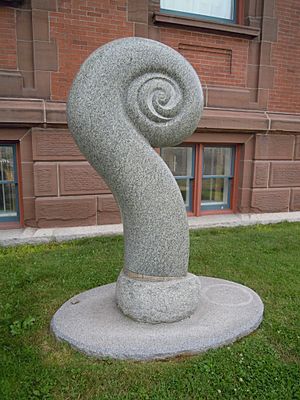
Arts and culture are a big part of Saint John's economy. The Imperial Theatre is home to the Saint John Theatre Company and Symphony New Brunswick. It hosts many plays, concerts, and shows all year. The Harbour Station entertainment complex is home to the Saint John Sea Dogs hockey team.
Saint John has many art galleries, especially in Uptown. Artists like Miller Brittain and Fred Ross lived here. Today, artists like Gerard Collins, Cliff Turner, and Peter Salmon have galleries. Other Uptown galleries include Paris Crew, Trinity Galleries, Citadel Gallery, Handworks Gallery, and the Saint John Arts Centre (SJAC). The SJAC hosts art shows, workshops, and smaller music events.
Major Industries in Saint John
Saint John has large industrial facilities on its East side. These include Canada's biggest oil refinery and the country's largest dry dock. K.C. Irving and his family built a huge industrial business in the city. They bought mills, shipyards, media companies, and other industries in the 20th century. Today, Irving companies are major employers in the region. They have an oil terminal, a pulp mill, a paper mill, and a tissue paper plant.
The Port of Saint John also creates a lot of economic activity.
Saint John has a long history of brewing beer. Today, it is home to Moosehead Breweries, James Ready Brewing Co., Big Tide Brewing Co., and Picaroon's. The Moosehead Brewery (started in 1867) is Canada's only independent brewery that sells across the country. Other important businesses include the New Brunswick Power Corporation, Bell Aliant, and Horizon Health Network. Many call centres also opened in the 1990s.
{{wide image|Stjohnpanoramo.jpg|880px|View from Fort Howe of the Saint John skyline before Peel Plaza.]]
Maritime Industries and the Port
Saint John is a major Canadian port. It is the only city on the Bay of Fundy. Until the early 2000s, Canada's largest shipyard (Irving Shipbuilding) was a big employer. In the 1980s and early 1990s, the shipyard built 9 of the 12 Halifax-class multi-purpose patrol frigates for the Canadian Navy. However, the Irving family closed the shipyard in 2003.
Research on marine life in the Bay of Fundy and the Saint John and Kennebecasis Rivers happens in the city. The University of New Brunswick's Marine Biology department leads much of this research.
Traditional fishing for lobster and scallops is still important for many Saint Johners. Fish farming, especially for Atlantic Salmon, has grown a lot. Cooke Aquaculture, a large company in this industry, is based in Saint John.
Before the St. Lawrence Seaway opened in 1959, the Port of Saint John was Montreal's winter port. This was because ice blocked shipping in the Gulf of St. Lawrence and St. Lawrence River. The Canadian Pacific Railway opened a line to Saint John in 1889. They moved most of their shipping to the port in winter. The port declined after the seaway opened and year-round icebreaker services started in the 1960s. Despite these changes, Port Saint John is the largest port in Eastern Canada by cargo volume.
Culture and Arts in Saint John
Saint John is the birthplace of many famous artists, actors, and musicians. These include Walter Pidgeon, Donald Sutherland, Louis B. Mayer, and Miller Brittain.
The period from 1940 to 1970 was a "golden age" for Saint John's arts community. During this time, the city produced famous artists and writers. These included poet Kay Smith, painters Jack Humphrey, Miller Brittain, Bruno Bobak, and Fred Ross. Sculptor John Hooper and folk-singer Stompin' Tom Connors also came from Saint John. Poet Bliss Carman once wrote about Saint John, "All the beauty and mystery Of life were there, adventure bold, Youth, and the glamour of the sea, And all its sorrows old."
Dance, Music, and Theatre
Comhaltas Saint John is a local branch of an Irish organization. It promotes traditional Irish music and culture. The JP Collins Celtic Festival celebrates Saint John's Irish heritage. It is named after a young Irish doctor who helped sick immigrants on Partridge Island.
Arts groups in Saint John include InterAction School of Performing Arts, New Brunswick Youth Orchestra, Symphony New Brunswick, TD Station, The Imperial Theatre, and the Saint John Free Public Library.
Film and Television in Saint John
Saint John entered the film industry in 1924 with the lost silent film Blue Water. This movie featured future Hollywood star Norma Shearer. Saint John returned to film with Bravery in the Field (1979). This short drama was filmed in the city and was nominated for an Academy Award.
Saint John was a filming location for Children of a Lesser God (1986). This romance drama received five Academy Award nominations. Marlee Matlin won Best Actress for her role. She became the youngest Best Actress winner and the first deaf winner in Oscar history. Other films shot in Saint John include The Secret Life of Algernon (1997) and Still Mine (2012). Filming for Taylor Olson's upcoming film Unseen also took place in the city in 2024.
On television, Saint John was featured in an episode of Hotel Impossible. It was also a filming location for Canada Russia '72 (2006), a miniseries about the Summit Series.
Museums to Explore
Saint John has many museums. These include the Hatheway Labour Exhibit Centre and the New Brunswick Black History Society's Black History Heritage Centre. You can also visit the Carleton Martello Tower, Fort Howe, the Loyalist House, and the Saint John Jewish Historical Museum. The Saint John Firefighters Museum and the Saint John Police Museum are also here. The New Brunswick Museum is Canada's first public museum.
National Historic Sites
Saint John is home to several National Historic Sites. These include old forts like the Carleton Martello Tower, a War of 1812 masonry tower. Other sites are Fort Menagoueche, Fort Howe, and Fort La Tour. The Imperial Theatre, the Loyalist House, the Saint John City Market, and Partridge Island are also historic sites. Prince William Streetscape and the Bank of New Brunswick building are also recognized.
-
The Imperial Theatre, a National Historic Site, still hosts live shows.
-
Prince William Street, a National Historic Site. The building in front is the Bank of New Brunswick, Canada's first bank.
-
The Carleton Martello Tower, a fort from the War of 1812.
Music Scene in Saint John
Early settlers brought music to Saint John. Working-class fishers, laborers, and shipbuilders shared Maritime folk songs. Wealthy people enjoyed classical music. Stephen Humbert, a Loyalist musician, moved to Saint John in 1783. He opened a music school and published the first Canadian English music book in 1801. The Mechanics' Institute, built in 1840, was a big stage for operas and concerts. In 1950, the Saint John Symphony was founded. It became Symphony New Brunswick in 1983. Many musicians from Saint John have become famous.
Music festivals have always been part of the city's culture. The New Brunswick Music Festival was held in Saint John each spring. Today, festivals like Area 506 and Quality Block Party showcase different types of music.
The Area 506 music festival happens every New Brunswick Day long weekend at Long Wharf. It uses shipping containers from the port for vendors. A main stage hosts local and major bands. Quality Block Party music festival features independent New Brunswick musicians in smaller venues.
Public Safety in Saint John
Police and Law Enforcement
The Saint John Police Force handles law enforcement. It was started in 1849, but police forces in the city date back to 1809. As of 2022, there were 139 officers. The police force moved to a new headquarters at Peel Plaza in 2012.
Fire Department Services
Saint John is served by the Saint John Fire Department, which started in 1786. There are six active fire stations across the city.
Military Presence
Saint John has several historical forts like Fort Howe and the Carleton Martello Tower. It is also home to several reserve units of the Canadian Forces.
- Naval Reserve
- HMCS Brunswicker
- 37 Canadian Brigade Group
- 3rd Field Artillery Regiment, RCA
- Royal New Brunswick Regiment (Carleton & York)
- 37 Signal Regiment
- 37 Service Battalion
Education in Saint John
Schools for All Ages
Saint John has two school boards. The Anglophone South School District serves English-speaking students. It is headquartered in Saint John. The Francophone Sud School District serves French-speaking students. It is based in Dieppe and serves Saint John's only French school, École Samuel-de-Champlain.
There are 25 public schools in Saint John for students from kindergarten to grade 12. Twenty-four are English-speaking, and one is French-speaking. Saint John High School is Canada's oldest publicly funded high school. Other high schools include Harbour View High School, St. Malachy's Memorial High School, and Simonds High School.
Colleges and Universities
Saint John has several post-secondary schools. One is the University of New Brunswick, Saint John campus (UNBSJ). It opened in 1969 and is near the Saint John Regional Hospital. About 2,000 students attend UNBSJ. Because it's close to the hospital, the campus also hosts Dalhousie Medicine New Brunswick. Saint John also has a campus for the New Brunswick Community College and Eastern College.
Public Library System
The Saint John Free Public Library first opened on May 18, 1883. It was one of Canada's first free libraries. It started in the Saint John City Market. It later moved to a building funded by Andrew Carnegie in 1904. In 1983, it moved to its current location in Market Square. The library now has three branches.
Working Life in Saint John
Canada's First Trade Union
Saint John is known as the birthplace of unionism in Canada. The city has a history of important labor achievements. Canada's first trade union, the Labourers' Benevolent Association (now International Longshoremen's Association Local 273), started here. In 1849, Saint John's longshoremen (dock workers) formed the union. They wanted regular pay and shorter workdays. They asked the city council for permission to put up a bell to mark the start and end of their 10-hour workday. Business owners objected, but citizens and longshoremen put up a larger bell anyway. The business owners then dropped their opposition. ILA Local 273 is still one of the city's strongest unions today.
The Saint John Street Railway Strike of 1914
The 1914 Saint John street railway strike happened from July 22 to 24, 1914. Workers on the street railway system went on strike. There were also riots in Saint John on July 23 and 24. This strike showed the tensions between railway owners and the working people in the city.
The Saint John General Strike of 1976
The Saint John General Strike of 1976 happened because of a new law called Bill C-73. This law limited how much workers' wages could increase. Many workers in Saint John were affected by this law. On February 5, 1976, unions in Saint John held a meeting to oppose the law. They organized rallies and protests. Five thousand people marched to King Square, and major industries in Saint John shut down.
The Irving Oil Refinery Strike (1994–1996)
On May 12, 1994, workers at the Irving Oil Ltd. Refinery went on strike. The strike lasted 27 months. Irving Oil wanted more flexibility from workers and changes to their pay and benefits. The union argued that Irving wanted to make the work week longer without paying overtime. This strike is seen as a symbol of how workers' rights have changed in North America.
Media and Communication
Print Media
Saint John's daily newspaper is the Telegraph-Journal. It was owned by J. D. Irving until 2022. The newspaper was created in 1923 by merging other papers. The University of New Brunswick Saint John campus also has a student newspaper called The Baron.
One of the first Black Canadian magazines, Neith, was published in Saint John in 1903–1904.
Television Channels
Saint John has two television stations: CHNB-DT (Global) and CKLT-DT (CTV). CHNB-DT operates out of Brunswick Square.
Radio Stations
Saint John has both English and French radio stations. Most are FM stations. Music stations play hot adult contemporary, adult contemporary, Christian contemporary, classic hits, classic/active rock, and country music. French stations include CHQC-FM (community radio) and two rebroadcast stations.
Saint John also has an English news/talk station, CBD-FM. The University of New Brunswick Saint John campus has a campus radio station, CFMH-FM.
Getting Around Saint John
Air Travel
Air service for Saint John is at the Saint John Airport. It is about 25 km northeast of the city center. Sunwing Airlines (seasonal) and Air Canada offer flights. Porter Airlines flies daily from Saint John to Ottawa and Toronto Island Airport.
Major Highways
The main highway in the city is the Saint John Throughway (Route 1). Route 1 goes west to the United States border and northeast towards Prince Edward Island and Nova Scotia. Another major highway, Route 7, connects Saint John with Fredericton. There are two main road crossings over the Saint John River: the Harbour Bridge and the Reversing Falls Bridge.
Rail Connections
The Reversing Falls Railway Bridge carries trains for the New Brunswick Southern Railway. This route goes from Saint John to Maine. Passenger train service in Saint John stopped in 1994. However, the Canadian National Railway and New Brunswick Southern Railway still provide freight service.
Port and Ferry Services
Port Saint John is where the Saint John River meets the Atlantic Ocean. Both the ocean and the river system can be used by boats from Saint John docks. Bay Ferries operates a ferry service, MV Fundy Rose, across the Bay of Fundy to Digby, Nova Scotia.
The Summerville-Millidgeville Ferry connects the Millidgeville neighborhood with Summerville. This ferry runs from April until winter.
Public Transportation
Saint John Transit is the largest public transit system in New Brunswick. It covers the most area and has the most riders. Bus service is provided by Saint John Transit for the Greater Saint John Area. Maritime Bus provides inter-city bus services.
Sports in Saint John
Saint John has been home to many sports teams. These include the Saint John Sea Dogs (Quebec Maritimes Junior Hockey League), the former Saint John Riptide (National Basketball League of Canada), and the Saint John Alpines (New Brunswick Senior Baseball League). The Port City Power, a new professional basketball team, is also based in Saint John.
Some major sporting events held in Saint John include:
- The 2022 Memorial Cup, which the Saint John Sea Dogs won.
- The Saint John Flames of the AHL played here from 1993 to 2003. They won the Calder Cup in 2000–2001.
- The 1999 and 2014 World Curling Championships.
- The 1998 World Junior Figure Skating Championships.
- The 1985 Canada Games.
At the college level, Saint John is home to the ACAA UNB Saint John Seawolves. This team represents UNBSJ and has six varsity sports: basketball, soccer, and volleyball for both men and women.
Sister Cities of Saint John
Saint John has special connections with other cities around the world. These are called twin or sister cities.
 Bangor, Maine, United States (1987).
Bangor, Maine, United States (1987). Shantou, China (1997).
Shantou, China (1997). Donghae, South Korea (2008).
Donghae, South Korea (2008). Koper, Slovenia (2009).
Koper, Slovenia (2009). Newport, Rhode Island, United States.
Newport, Rhode Island, United States.
|
See also
 In Spanish: Saint John (Nuevo Brunswick) para niños
In Spanish: Saint John (Nuevo Brunswick) para niños


